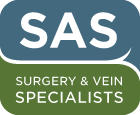Frequently Asked Questions
Breast Cancer
+What are my options for the treatment of breast cancer?
SAS Surgery & Vein Specialists is proud to provide the most advanced options for the treatment of breast cancer here at home. We perform breast biopsies for the diagnosis of breast cancer as well as mastectomies and breast conservation surgery to preserve healthy breast tissue in the treatment of your cancer. Drs. Nedelman and Daniels also are proud to offer sentinel lymph node biopsies and a new surgical option called MammoSite. This innovative treatment involves the placement of a catheter which reduces radiation treatments from 5 weeks to 5 days and provides partial breast irradiation. Our surgeons are committed to providing state of the art treatment within our community. Be sure to discuss your treatment options with our health care professionals.
Hernia
+What is a hernia?
A hernia is a protrusion or “herniation” of tissue through an abnormal defect or hole in the muscle. Hernias are classified according to location and type. The most common hernias are inguinal or groin hernias, umbilical (belly button) hernias and abdominal wall (ventral hernias). Most hernias present as a buldge or lump in the affected area. There may or may not be associated pain or discomfort.
Are hernias dangerous? The most serious complication of a hernia is an entrapment or incarceration of tissue through the muscle defect. This usually presents as a painfule lump that cannot be pushed back. If a portion of bowel becomes trapped, this could result in a bowel obstruction and the need for immediate surgery. Larger hernias and hernias which are more difficult to reduce are at a greater risk for incarceration.
+Why did I get a hernia?
Many hernias occur in areas of inherent weakness such as the groin, belly button or previous incision. People at risk for hernia formation include patients who smoke, are overweight, have lung disease, or do frequent lifting at work.
+How do you fix a hernia?
There are several ways to surgically repair a hernia. Many hernias are repaired on a same day surgical basis. Your surgeon may recommend an open or laparascopic repair. Most hernias are patched with a specially designed piece of prosthetic mesh. This results in less pain post operatively and a lower chance of hernia recurrence. Your surgeon will discuss the options for repair and make recommendations on the type of repair he/she believes is best.
+What complications may occur from surgery?
Serious complication is uncommon with most hernia repairs. Post operative bleeding or bruising, infection or prolonged discomfort occur infrequently. Most patient require pain medication the first post operative week. Many patients may resume normal activity in two weeks after hernia repair. Not all hernias are the same and your doctor will give you specific instructions regarding your hernia repair.
Laparascopic Cholecystectomy
+What is my gallbladder and do I need it?
The gallbladder is a nonvital organ that stores and excretes extra bile that is made by the liver. The gallbladder will squeeze out bile into the common bile duct which then empties into the intestine to help digest and absorb fat. The majority of patients return to eating normal diets after surgery. Occasional diarrhea is not uncommon a week or two after surgery. Avoid fatty or greasy foods initially.
+How much pain will I have after laparascopic cholecystectomy?
Most patients report feeling mild to moderate discomfort for a couple days after surgery. A mild sore throat occurs from the placement of a breathing tube during the surgery. Carbon dioxide gas is used to inflate the abdomen. This results in a “full” or bloated feeling for a few days. It may also result in shoulder or back pain in the post operative period. Your doctor will provide you with the necessary pain medication to contol post operative pain. The incisional pain is minor. You will notice some discomfort when you take a deep breath or cough.
+What problems should I look for after surgery?
Complications are infrequent after surgery. The sudden onset of severe abdominal pain may indicate a leakage of bile from the liver. You should contact your doctor immediately if this occurs. An infection of the incision will present a few days after surgery. The incision will appear red and tender to the touch. In general you should gradually feel better day by day. Do not hesitate to call the office if you believe you are having problems.
+Should I avoid lifting?
Lifting is unlikely to be harmful. Due to the small incision,hernias rarely occur. Lifting and normal daily activity will not jeopardize the surgery. You may resume activities of daily living as soon as you feel able. Vigorous exercise is not advisable until your doctor gives you clearance. You may shower a day or two after surgery and allow your incisions to get wet. Apply bandaids to your incisions if your dressings come off.
+When will I be able to go back to work?
Most patients return to work within 2 weeks. Discuss with your doctor the most appropriate time to return to unrestricted activity.
Varicose Veins
+What can I do about varicose veins and leg pain?
We now offer a variety of treatments for the manifestations of superficial venous reflux, including varicose veins, swelling, pain, and ulcers. The Venefit™ Closure procedure is performed in the office setting and allows a much quicker recovery than traditional surgery. Please visit the Venefit™ Closure website found in the links section of our website for more information on this exciting minimally invasive treatment for superficial venous reflux disease. For more information visit the Vein Center.
